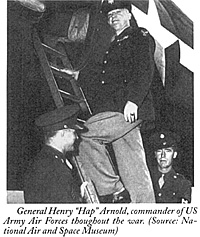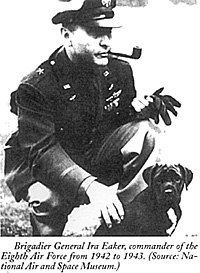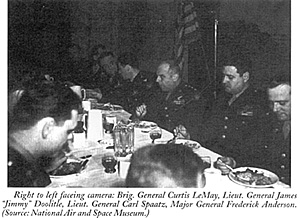 The horrors of trench warfare in
Europe during the First World War caused a
reevaluation and re-thinking of the way wars
were fought. During the inter-war years of
the 1920s, a growing school of radical
thinkers, led by the Italian General Giulio
Douhet, developed the theory that aerial
bombardment would be the decisive tactic in future wars.
The horrors of trench warfare in
Europe during the First World War caused a
reevaluation and re-thinking of the way wars
were fought. During the inter-war years of
the 1920s, a growing school of radical
thinkers, led by the Italian General Giulio
Douhet, developed the theory that aerial
bombardment would be the decisive tactic in future wars.
General Henry "Hap" Arnold, commander of US Army Air Forces thoughout the war. (Source: NationalAir and Space Museum)
A nation with a huge fleet of multi-engine, heavily-armed bombers could simply ignore the carnage and stalemate of the front lines, fly deep into enemy territory, and bomb key cities and industries into oblivion. Convinced that the bomber could not be stopped, Douhet and his disciples, Lord Trenchard in Britain and General William Mitchell in America, pushed for the construction of strategic bombers and the development of a force that could use them to good effect.
The theory was controversial, to say the least. At the beginning of the Second World War, only the strategic bomber programs of the United States and Great Britain had survived the inter-service rivalries and budget cuts of the pre-war years.
British Bomber Command was given the first opportunity to demonstrate its prowess when Germany declared war on Poland in September, 1939. Britain could do little to help the Poles directly, but they could certainly bomb German naval units operating in the North Sea.
On 18 December 1939, 22 Wellington Bombers from No. 9,37, and 149 Squadrons set out to find and destroy German ships operating in the Heligoland Bight. The British bombers were detected on German radar and intercepted by 32 Messerschmitt Me-109s and 16 Me-110s. In a matter of minutes 12 bombers were destroyed with no loss to the interceptors.
The results of the battle caused the British to modify their bombing theory. Although Douliet called for precision daylight bombing, the British were not prepared to absorb the staggering losses of daylight operations.
Bomber Command thus converted to night area bombing, leaving the Americans as the only proponents of daylight precision bombing.
General Henry H. Arnold, the Commander of the Army Air Corps, and his staff evaluated the British experience and drew a completely different conclusion. Night bombing was safer, but experience and independent evaluation showed that many of the early night bombing missions did not get a bomb within five miles of their intended targets. If a target or series of targets was to be devastated efficiently, it would have to be attacked during daylight.
Although the British feared the Luftwaffe day fighters, the Americans were convinced that their heavily-armed Boeing B-17 Flying Fortresses, flying in close formation, could shoot their way through to the target.
US 8th Air Force
General Arnold appointed Major General Carl Spaatz to command the Army Air Forces in Europe. He was given the 8th Air Force, which was established on January 28th 1942, specifically to carry out the strategic bombing campaign against Germany. The new Air Force had a planned strength of 3,500 airplanes formed into sixty combat groups. These would be divided into seventeen heavy, ten medium, six light, seven observation, twelve fighter, and eight transport groups.
While the Army Air Corps assembled the aircraft, men, and equipment to outfit the 8th Air Force, a liaison team lead by Brigadier General lra C. Eaker left for England to prepare the way for the new unit. The liaison team estimated that the 8th Air Force would need a total of seventy-five airfields and the British gave them most of the fields in East Anglia.
The 8th Air Force began its movement overseas on April 22, 1942, when the 97t Bombardment Group, flying the Boeing B17E Flying Fortress, arrived in England, They were followed, throughout the summer, by an ever-increasing flow of bombers and fighters.
On August 17th, 1942 General Eaker, the commander of the Sth Air Force led twelve B-17Es against the railway yards at Rouen, France. The force was heavily protected by the RAF, did little damage, and suffered no casualties. However, the Americans had served notice that their bombers were in the war against Germany.
The early strength of the 8th Air Force was built around four Groups of B-17Fs (140 aircraft), two Groups of B-24Ds (few were available for operations), three groups of Lockheed P-38F Lightnings, three groups of Supermarine Spitfires, and an assorted mixture of reconnaissance, transport, and liaison aircraft.
Although it was an impressive force, the men had much to learn; and the missions flown between November 1942 and May 1943 were restricted to enemy targets located close to the coast or within range of heavy RAF fighter protection. The enemy fighter fields at Abbeville and the submarine pens at Brest and St Nazaire were among the favorite targets of the 8th Air Force during its early period. The experience gained on these early raids was invaluable. Although they did little damage, the crews gained experience with little chance of catastrophic losses.
While the Americans were gaining experience during these early raids, the German defenders were also experimenting with the best way to defeat the new American bombers. The Germans had two excellent fighters to defend the sky over the Reich: Messerschmitt Me-109G and the Focke-Wulf FW-190A. Both these fighters were heavily-armed, high-speed interceptors.
They were backed by slower, even more heavily-armed Messerschmitt Me-110s, Me410s, and Junkers Ju-88s that were classified as bomber destroyers. The Luftwaffe assembled 964 single-engine fighters and 682 twin-engine fighters by late summer to defend the Reich from the growing American and British air armadas.
Luftwaffe fighter squadrons Jagdgeschwader(JG) 2 and 24, which defended the area frequented by the American bombers on these early raids, also tested a variety of different tactics to find the weak spots in the new bomber.
Attacks were made from above, below, and the side. However, the most effective was head-on, where the defensive armament of the bombers was the weakest. By the spring of 1943, both sides had marshalled their strength and were prepared to do battle in earnest.
 Brigadier General Ira Eaker, commander of the Eighth Air Force from 1942 to 1943. (Source: National Air and Space Museum)
Brigadier General Ira Eaker, commander of the Eighth Air Force from 1942 to 1943. (Source: National Air and Space Museum)
In April 1943, General Eaker was convinced that his 8th Air Force was ready to conduct daylight precision raids against strategic targets in the Reich. After careful analysis of the German war effort, he and his staff decided that several key industries could efficiently be reduced and thereby have a devastating effect on the German war effort. His bombers would go after industries that produced submarines, aircraft, ball bearings, oil, synthetic rubber, and military vehicles.
General Eaker outlined his first priority in the "Point Blank" directive, which made the destruction of the enemy's aircraft industry the first and primary target. The planners reasoned that once the Luftwaffe was crippled, the rest of the targets in Germany could be easily destroyed.
On 17 August, 1943 the Americans launched 376 Boeing Flying Fortresses against the German ball bearing industry at Schweinfurt and the aircraft factories at Regensburg, Germany. The targets were deep in Germany, far beyond the range of any escorting fighters, and the Luftwaffe and German flak defenses were fully alerted. It was the first real test of American daylight bombing.
The Americans reached the target and dropped 724 tons of bombs on the target, but the German fighter aircraft attacked relentlessly. During the battle they shot down 60 bombers, fully 16% of the force, and shot up 138 other bombers, which limped back to their bases with many wounded or dead crewmen on board.
After the drubbing at Schweinfurt, the 8th Air Force confined its activities to the easy targets in France and along the coast while it rebuilt its strength, added escort fighters, and re- evaluated its bombing strategy.
The Americans possessed the rugged, heavilyarmed Republic P-47 Thunderbolt, which had a range of 325 miles without auxilliary fuel tanks, and the Lockheed P-38 Lightning. with a range of 2,400 miles with extra fuel tanks. Both these fighters were excellent machines, but there were too few of them. The short range of the Thunderbolts also kept them from escorting the bombers deep into Germany.
On 9 October, 378 B-17s took off on a deep penetration mission to bomb the aircraft factories at Marienburg, Poland. The mission would take them out over the North Sea, across northern Germany, and then east along the Baltic coast.
 Right to left facing camera: Brig. General Curtis LeMay, Lieut. General
James 'Jimmy" Doolitle, Lieut. General Carl Spaatz, Major General Frederick
Anderson. (Source: National Air and Space Museum)
Right to left facing camera: Brig. General Curtis LeMay, Lieut. General
James 'Jimmy" Doolitle, Lieut. General Carl Spaatz, Major General Frederick
Anderson. (Source: National Air and Space Museum)
The mission, well outside of American fighter range, flew directly into the teeth of the Luftwaffe. The bombers dropped 761.6 tons of bombs on Marienburg, but the Luftwaffe was out in force. During the air battle across Germany, they destroyed 28 bombers and damaged 148 others.
Despite the heavy losses the Americans were convinced that they were shooting the Luftwaffe out of the air. The 8th Air Force sent 313 bombers on a mission to Munster the next day. They put 700 tons of bombs on the railroad yards but lost 30 bombers and had another 105 shot up. Still, the gunners reported shooting down 183 enemy aircraft and the High Command was certain the Luftwaffe was all but destroyed.
On 14 October, 320 bombers took off to bomb Schweinfurt again. If indeed the Luftwaffe was suffering heavy losses, the time would be ripe to destroy the ball bearing industry, which was so vital to aircraft production.
Unfortunately, the gunners' estimates had been wildly exaggerated. A German fighter diving at 400 mph through a formation of hundreds of bombers would be claimed destroyed by dozens of gunners, when in fact, the fighter had survived the attack.
As the bomber force headed for Schweinfurt, the Luftwaffe launched hundreds of fighters. The bombers made it to Schweinfurt and dropped 482.8 tons of bombs on the city, but enemy fighters shot down 60 bombers and damaged 145 others.
The three days of heavy losses convinced General Eaker that the 8th Air Force had to have a fighter that could escort it to the target and back. Without this long range protection, the bomber offensive would be defeated by the Luftwaffe. Fortunately, help was on the way.
The new North American P-51 Mustang fighter was just arriving. Equipped with drop tanks, the new fighter had a 2,300 mile range and the maneuverability and firepower to defeat any Luftwaffe fighter. It took several months to get enough Mustangs into the theater, and during that time the 8th Air Force confined itself to bombing targets in France and along the coast.
On 9 March, 1944,730 bombers of the 8th Air Force, escorted by 801 fighters (including 100 Mustangs), launched the first American raid against Berlin. The raid was part of a combined attack with the RAF to destroy the city. The Americans dropped 1,648 tons of bombs on the city and lost 69 bombers with an additional 353 damaged. However, the Luftwaffe suffered heavily for the first time, with the American fighters accurately claiming 81 aircraft destroyed.
With the arrival of the Mustangs, the loss rate of the bombers fell from 9% to just over 3% per mission in a matter of weeks. The bombers of the 8th Air Force, escorted by an ever growing number of Mustangs, were now capable of flying deep into enemy territory and destroying Germany's vital industries. The Americans had seized the initiative.
The Americans dropped 85,000 tons of bombs on Germany during July and August 1944, compared with 7,500 tons a year before. Under this rain of destruction, the Germans tried to diversify their industry and introduced newer versions of fighters propelled by jets and rockets to defeat the allied fighters.
The Messerschmitt Me-262, Arado 234, and Heinkel He-162 jet fighters and the Messerschmitt Me-163 rocket fighter were all introduced to counter the growing number of Mustangs, Thunderbolts, and Lightnings that roamed the sky over the Reich. The German jets put a scare into the allies but by the time they were produced in any quantity the war was almost over. The allies simply put standing air patrols over the German jet bases and destroyed them as they took off or landed.
Throughout 1944 and into 1945, the strategic bombing offensive pummelled the Reich. The industrial cities of the Ruhr were systematically devastated, synthetic fuel production facilities were leveled, and transportation nets were obliterated by the armada of allied bombers that roamed the day and night sky over the Reich.
By the spring of 1945, the American bombing campaign had gutted most of Germany's major cities and vital industries. The bombing campaign did not win the war as many experts had predicted, but the offensive contributed substantially to victory. It robbed the Germans of the initiative in the air, crushed many of their vital industries, and sapped the morale of their people.
The Air War of WWII
Back to Table of Contents GameFix # 4
Back to Competitive Edge List of Issues
Back to Master Magazine List
© Copyright 1995 by One Small Step, Inc.
This article appears in MagWeb.com (Magazine Web) on the Internet World Wide Web.
Other articles from military history and related magazines are available at http://www.magweb.com